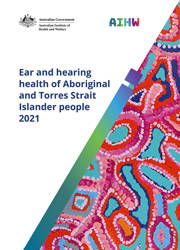Ear and hearing health of Aboriginal and Torres Strait Islander people 2021
Citation
AIHW
Australian Institute of Health and Welfare (2022) Ear and hearing health of Aboriginal and Torres Strait Islander people 2021, AIHW, Australian Government, accessed 19 April 2024. doi:10.25816/5cbx-0z80
APA
Australian Institute of Health and Welfare. (2022). Ear and hearing health of Aboriginal and Torres Strait Islander people 2021. Canberra: AIHW. doi:10.25816/5cbx-0z80
MLA
Australian Institute of Health and Welfare. Ear and hearing health of Aboriginal and Torres Strait Islander people 2021. AIHW, 2022. doi:10.25816/5cbx-0z80
Vancouver
Australian Institute of Health and Welfare. Ear and hearing health of Aboriginal and Torres Strait Islander people 2021. Canberra: AIHW; 2022. doi:10.25816/5cbx-0z80
Harvard
Australian Institute of Health and Welfare 2022, Ear and hearing health of Aboriginal and Torres Strait Islander people 2021, AIHW, Canberra. doi:10.25816/5cbx-0z80
PDF | 3.9Mb
This is the inaugural national report on the ear and hearing health of Aboriginal and Torres Strait Islander children and adults. Indigenous Australians experience excessive rates of ear and hearing problems which can have profound impacts on overall health and quality of life. This report brings together information on the prevalence of ear and hearing problems among Indigenous Australians along with insights on key protective and risk factors.
- ISBN: ISBN 978-1-76054-962-6
- DOI: 10.25816/5cbx-0z80
- Cat. no: IHW 262
- Pages: 174
-
In 2018–19, more than 2 in 5 (43%) Indigenous Australians aged 7 and over presented with hearing loss
-
Almost 7,000 hospitalisations took place for Indigenous Australians for ear or hearing problems in 2018–20
-
In 2018–20, there were 9,400 ear or hearing-related emergency presentations by Indigenous children aged 0–14
-
2018-19 hearing loss in Indigenous children was higher in Remote and very remote than Major cities (40% and 23%)



